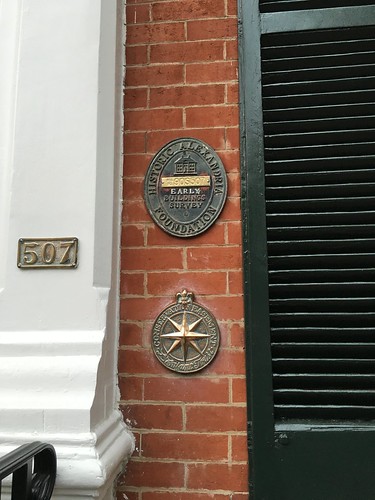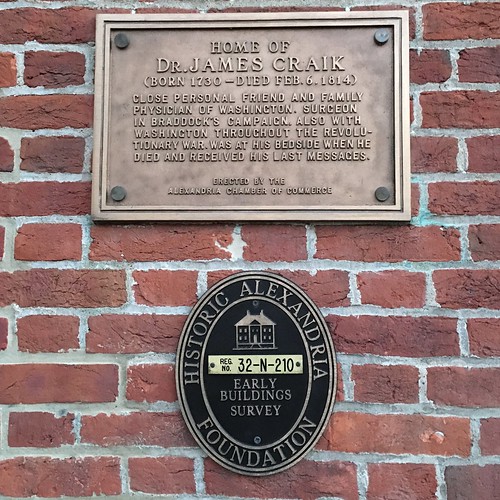If you've ever visited Old Town, you've no doubt seen the oval metal historic markers adorning the front of many residences and old buildings.
These little plaques are so significant that they are often mentioned in Old Town Alexandria real estate listings as a selling point for a property that has one.
Anyone who has noticed and been intrigued by one of these signs in Old Town, has possibly seen the hundreds of other historic markers throughout our town. Alexandria, like many neighborhoods and towns with old homes or historic designation, has no shortage of historic markers and antique looking signs decorating the front of the various homes and buildings. I know it's one of those things that I pick out almost immediately whether we're at home or on vacation, such as the plaques you might see on houses in St. Michaels, Maryland.
From talking with various people about this very subject over the years, it seems many wonder the same things as I have. Specifically "how did that marker get there in the first place," and "if there's a plaque on the front of the house, does that mean the owners can't make any changes to the house without some kind of act of congress for approval?" The simple answer is that it's not so simple.
What I've learned about these signs over the years is quite interesting. At least to a house nerd like me. And I'd like to share a little about what I've learned about the plaques you see in and around Old Town Alexandria.
Really, these signs fall into three distinct categories:
- Decorative
- Official Recognition
- Easement Declaration
- Informational (Sometimes Donated)
Decorative
Signs that are on the building simply as decoration are probably some of the most common throughout the country, but seem to be less common in our historic town. Typically these fall into the "Fire Insurance Marks" plaques category.
The historically inspired plaques are rooted in tales of Benjamin Franklin's insurance company/fire fighting brigade, who would only fight the fire at your house if they arrived to find one of their plaques on the front of your home. The truthfulness and authenticity of these stories are debatable, but that doesn't keep the sales of these plaques down.
While Fire Marks are more at home and accurate in Philadelphia (or Europe, where they were started in London after a great 17th century fire), they're a fun addition to buildings in any historic town. However, I do have it on authority from a guide at the Friendship Firehouse in Old Town that Fire Marks were not used in Alexandria, so any you see are purely decorative and likely modern additions. Sorry to throw a bucket of water on the Fire Mark story...see what I did right there?
Official Recognition
In Old Town the single most common plaque you see are the oval markers from the Historic Alexandria Foundation (HAF). These markers stem from a project started in the 1960s called the "Early Buildings Survey" to recognize, and ultimately protect, the homes in the historic district of Alexandria.
Over the years the criteria for receipt of these markers has been refined from its less strict origin to a more stringent review process. Today, a home of 100 years old or more with intact architectural integrity will qualify after an application is submitted, a fee is paid in support of the foundation, and independent architectural review and approval is conducted. If granted, a bronze plaque like the one above is delivered and a registration number is assigned to the property. Though our home doesn't yet have one of these, I have dreams of one day attaching one just below our front light.
Beyond the HAF plaques, there are two other types of official recognition. The first is at the state level when the state designates a building as a Virginia Historic Landmark. The first page of the entire inventory and then some is all in Alexandria. On the buildings this designation is denoted with a small grey marker that also shows the name of the property as it's officially recognized.
These markers typically indicate that the building was either home to someone important and influential, or the building itself was significant in some way (or both). Documentation and research was done to prove these facts, and the state's historic commission reviewed the documentation and approved the designation.
In addition to markers on the homes themselves, there are often roadside markers placed by the Virginia Department of Historic Resources, such as the one that stands in front of the Lee-Fendall House.
These go into much more detail and, to be honest, would look a bit foolish stuck to the front of a house.
In addition to the state level recognition, there is a National Register of Historic Places designation from the Department of the Interior and the National Park Service. This is a much more restrictive list and needs to have some level of national historical significance with either the past residents or architecture. Any time you see one of these, this building has had some significant impact in the fabric of America's history.
Alexandria has many structures on the National Register of Historic places, but sometimes the markers aren't quite as straight forward to find. For example, the marker on the front of Christ Church, the family church of George Washington, goes into much more detail than the more simplified marker from the previous photo. This often has to do with when the historic designation was granted. The sign above was applied more recently, but the Christ Church sign was placed in 1970.
It's a very fun "game" to see how many markers of historic designation you can pick out on any given walk around our town.
Easement Declaration
While the oval plaques, and those for the various state and National Registers, offer a documented level of significance regarding the structure, it doesn't go as far as preventing alterations. While the building may lose designation if altered significantly, the owner of the property retains full ownership of the building. However, there's another plaque you will see less frequently that denotes a specific preservation easement exists on the facade (or sometimes more) of the building.

507 Prince Street easement medallion
These golden brass star medallions that I've seen on homes in Alexandria and in Georgetown denote the existence of a preservation easement. In pretty basic terms, the owner of the home, at some point in the past, has actually sold the rights to part of the home to another entity. In this case, the star medallion represents a specific group. That group now has ownership of the facade and any alterations must go through that group for approval. The idea is that the group will work to preserve the historic integrity of the building for now and the future.
Preservation easements are offered by several organizations and can be very lucrative for the ownership of the property as it can mean big tax breaks. The breaks are based on the value of the home and are offered because the easements theoretically reduce the value of the home. However, in an historic district that already has restrictions on alterations, the hit on value is often negligible and is far outweighed by the tax benefit. The owner saves some money and the house's history can be preserved. It really becomes a win/win.
Informational
Beyond the more official easement, foundation, or government markers, there are quite a few plaques that you see all over Old Town that are not national, state, or local government recognitions, but are meant to provide some level of information and gravitas regarding the historic nature of the property.These are often companion plaques to more official markers and are quite frequently arranged together.
One thing you'll notice about the informational signs is a simple rule of thumb. If George Washington had anything at all to do with the property in any way...it needs a sign stating this. Whether we're talking about the Old Presbyterian Meeting House where Henry "Light Horse Harry" Lee delivered Washington's eulogy and the famous "First in war, first in peace, and first in the hearts of his countrymen."...
Or the house of the man who actually delivered the eulogy about Washington.
Or the house that was built for Washington on the lot that George Washington once owned early in Alexandria's history.
Or that the house belonged to Washington's friend and personal physician.
Or that it belonged to another of Washington's physician's who was present when he died (he had a lot of doctors).
Or that it was built by someone who was a friend of Washington.
Or the townhouse that is a replica of the house that Washington owned that was torn down in 1855 but was rebuilt built with parts of that original house in 1960.
There seems to be a "Washington" story no matter where you look in the Washington D.C. area. Go figure. This is just a small number of the many signs you'll find about Washington all over town. Hey, he's responsible for where we are now, so I get it.
Though it may not seem this way, not every informational sign in Alexandria is about George Washington, some are about the other influential people that built grand homes in the area.
And some informational signs are simply about the building and what it was in its history.
What was once the city jail is now a very lovely home.
In some cases the building won an award of some sort and its marker, such as with City Hall's "Test of Time" award from the American Institute of Architects, is to recognize the declaration.
The thing to remember about all of these plaques is that a building, no matter what it is today, likely has a rich history and many interesting stories. And while not every home has a marker to display, so many do that it feels a little bit like the walls of homes in Alexandria are able to talk.
But if all else fails and you don't have some rich known history to draw from, just remember, you can always go the route of bringing a smile to someone's face.

![]()
![]()